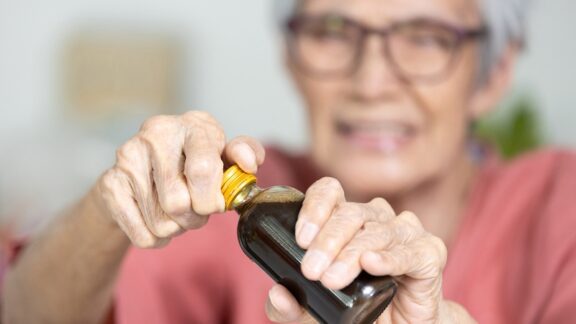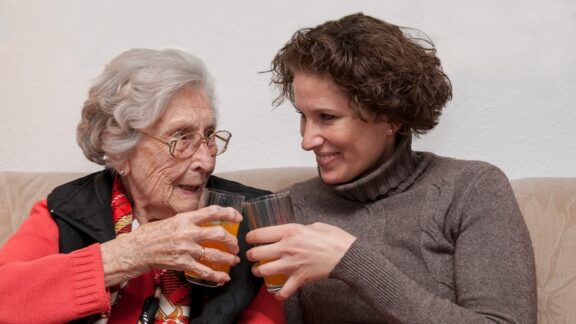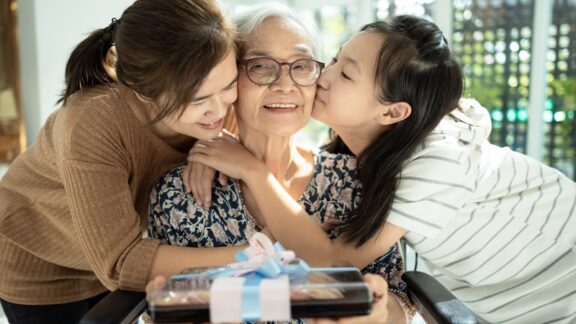If you or a loved one is aging in place – staying in their own home rather than moving to a senior community – there are many improvements to make the living space safer and to improve accessibility. These modifications for home safety for aging in place range from simple, low-cost solutions to more expensive and permanent home modifications.
Easy modifications to reduce fall risks
- Remove tripping hazards: Eliminate loose scatter rugs, exposed electrical cords, and clutter, especially in or around doorways or stairways.
- Secure large rugs and carpets: Apply nonslip backing or tape to hold down the corners of rugs and to secure them in place.
- Improve lighting: Replace dim or nonworking bulbs in lamps and light fixtures with brighter options and add lamps or lights in low-lit areas.
- Add nonslip mats: Nonslip mats or strips in areas that might get wet, such as the kitchen and bathroom, are an inexpensive way to reduce slips and falls.
- Make it easier to get in and out of bed: Add bed-assist rails or a floor-to-ceiling security pole to help your loved one get in and out of bed. Also consider lowering the height of the bed.
Changes for improved accessibility
- Replace doorknobs with lever handles: Lever handles are easier to use for opening doors than doorknobs.
- Install touch-activated faucets: These enable seniors to turn water on and off with just a light touch.
- Replace or relocate light switches: Replace traditional light switches with rocker switches. If your loved one is in a wheelchair, consider adding motion-sensor lights or moving light switches so that they’re lower on the wall. Bonus if the light switches are slightly illuminated to be visible in the dark.
- Add smart home devices: Voice-controlled devices make it easy to operate lights, small appliances, and alarm systems.
Ensuring your loved one is prepared for home emergencies

- Check smoke and carbon monoxide detectors: Ensure that these life-saving devices are in good working order and replace as needed.
- Have a working fire extinguisher on hand: Make sure that working fire extinguishers are easily accessible in the kitchen and any other location in the home that might be prone to a fire.
- Install a security system: Smart doorbell, surveillance cameras, and security systems provide additional peace of mind.
- Be prepared: Create an emergency plan that will ensure your loved one can contact help immediately in case of an emergency.
Permanent home modifications
- Replace tubs with walk-in models: Converting or swapping out traditional tubs for walk-in showers and tubs with low points of entry can make self-care easier and safer.
- Install grab bars: Placing bars in bathtubs and showers and near toilets will support safety and independence.
- Install nonslip flooring: Replace ceramic tile and other hard flooring with nonslip options made from rubber, cork, or textured tile.
- Add ramps with handrails: When it’s no longer safe to navigate steps, especially if someone becomes wheelchair bound, ramps will ensure they can move safely in and out of and around the house.
- Widen doorways: Widening narrow doorways makes room for mobility devices, from walkers to wheelchairs.
- Install a chairlift: For loved ones in multistory homes or for those confined to wheelchairs, a chair lift or in-home elevator makes moving from one floor to another easier and safer.
Resources on home safety for aging in place
- The National Association of Homebuilders has a directory of Certified Aging in Place experts.
- Your local Area Agency on Aging can help you determine if you are eligible for assistance to help pay for home modifications. Several government programs offer funding assistance for home improvements for the elderly, including the USDA Rural Housing Repair Loans and Grants program, HUD’s Older Adult Home Modification Program, and the Medicaid Home Modifications Waiver Benefit.
- Follow this helpful advice for choosing a home care agency.
- If your loved one is isolated at home, consider enrolling them at a local senior center or an adult day care. These services are great for reducing isolation and for giving you and other caregivers a break.
- Browse these related articles on safety for aging in place:




